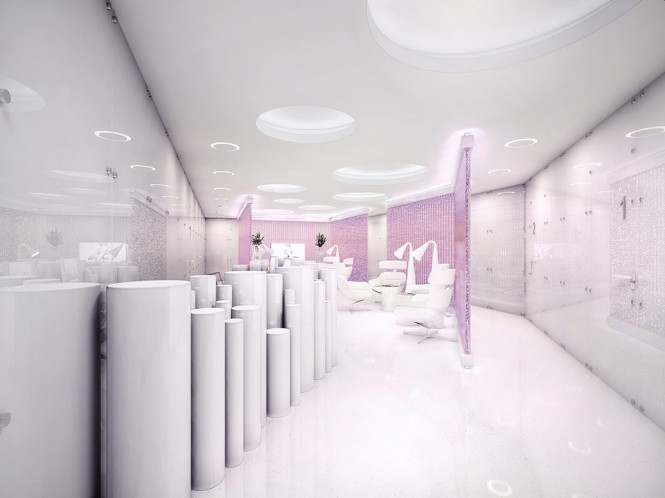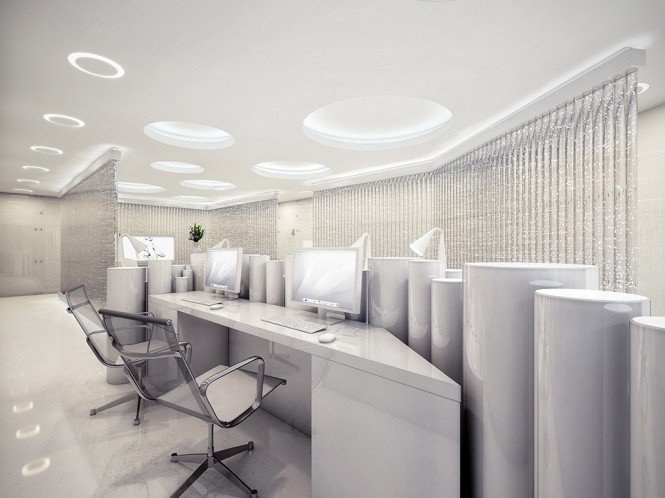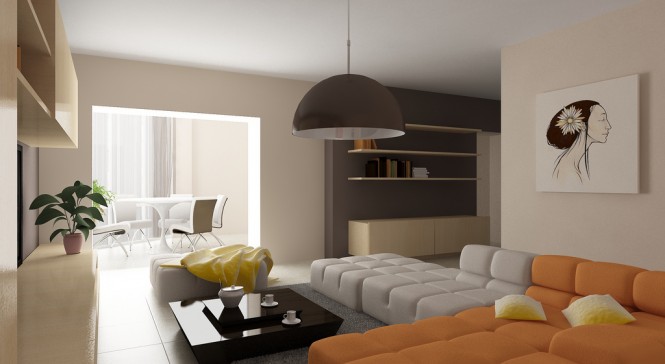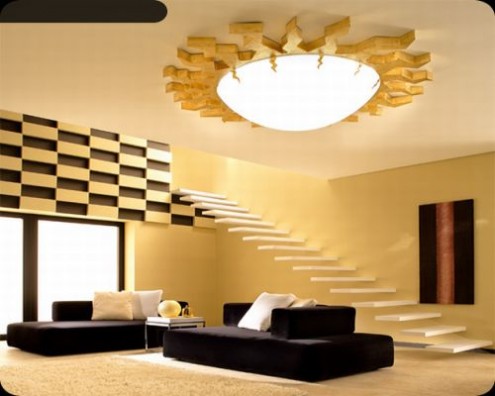| House A | Takeshi Hamada Posted: 26 Apr 2011 09:00 AM PDT 

Japanese architect Takeshi Hamada recently has completed the Narrow House in downtown, Abeno-ward, Osaka, JAPAN. Background, Atmosphere The location is Abeno-ward Osaka, JAPAN. Though it is a superb location just 10 minutes from Tennoji Station, it is in the downtown streets filled with traditional emotion, there are traditional tenement houses, old houses and shops, just 1 block from the main street. I planned the house in the narrow vacant land for 56-square-meters in this area. The house is light and open, and the residents can enjoy their hobbies.  House A, image courtesy Takeshi Hamada Its owner, K families, those are a couple and one daughter, like music.
Especially, their daughter, who is 27 years old, is a musician and received fifth winner in the recital. This family requested "Hobby Room, Live Studio" in their house that they can enjoy music. Sometimes, they will open mini concert with other band members and usually, they will use the room as an art gallery. And sometimes, they want to have a party with close friends by drinking. To maximize the locality with good access, that can create linkages between people through hobbies, such space was required.  House A - Floor plans, drawing courtesy Takeshi Hamada Architectural Plan Use as a distribution, I planned the first floor for “Hobby Room (studio and gallery and bar, live) ” and a few floors as a living space. For Live Studio, because high sound insulation is required, I used the RC sturucture for the first floor, and I considered soundproof for doors, sashs, ventilators, and among others. On the other hand, I tried to make cost down in total for the second and the third floor, by using symple space of Japanese traditional woodern structure.  House A, image courtesy Takeshi Hamada Facade Picture
RC Fair – faced with a facade of spraying material. Stainless steel bay window adds accents.  House A, image courtesy Takeshi Hamada The first floor, "Hobby Room"
To ensure maximum width of the building, the concrete formwork for the construction with adjacent separator and exterior insulation was used. As a result, Interior walls and ceiling are fair – faced the decorative RC. For the floor, I adopted used scaffold boards of cedar wood. For the flexibility to cope with the internal scene, the lighting equipment and orientation can be adjusted to the light. The third floor, LDK
To achieve low cost, a few floor living space has a simple wooden structure and space. Especially, the third floor studio is a one room space with no joynery. By exposing the column and beam with bracing, the spatial and visual spread is ensured. The floor is solid wood used in unpainted pine.
Since the change in color and luster through the years, they can enjoy the aging of the material. The Second Floor
There are daughter’s and parents' bedroom with bath, toilet and kitchen.
Since it's difficult to get enough light by approaching the neighbors, I used top lights and side lights to receive natural ligjhts as much as possible. The floor is solid wood used in unpainted pine. Live Scene
Once or twice a month, band friends of the owner gathere to perform a concert. Live in the past, overcrowded by standing audience, ended in great success.  House A, image courtesy Takeshi Hamada  House A, image courtesy Takeshi Hamada + Project credits / data Project: House A
Architect: Takeshi Hamada | http://hamada-design.com/
Location: Abeno-ward, Osaka, JAPAN
Construction: August 2010, March 2011
Structure: First Floor: Reinforced Concrete Second and Third
Floor: Wooden Structure
Site Area: 59.34 m²
Building Area?45.82 m²
Floor Area?128.28 m² | 1F 43.66m², 2F 54.82m², 3F 38.80m²
Typology: House + All images and drawings courtesy Takeshi Hamada               |
| CCPP – Space, light, sound and drugs | Cochenko & Quatorze Posted: 26 Apr 2011 04:07 AM PDT 

CCPP – Chantier créatif de prévention partagée -Space, light, sound and drugs  CCPP, image courtesy Per Lundström CCPP is a design collaboration between the Collectifs Cochenko and Quatorze. It was carried out by Butong together with the two collectives. The installation will travel to schools and institutions in a drug awareness campaign commissioned by the French Ministry of Culture and MILDT. Through the creation of a hallucinogenic space, chance is given to discuss drugs with the visitor. Space, light and sound is interacting with the visitor, giving a personal experience created by the visitors movement and mindset. Only one person is allowed inside at a time and may stay for as long as he/she wants to.  CCPP, image courtesy Per Lundström The installation contains three continuously linked spaces – pleasure, repetition and awakening. Entering the first space, the door is shut behind the visitor, who is given beauty and tranquillity. Soft, crystalline music and subtle light phenomenons, bring peace and pleasure.  CCPP, image courtesy Per Lundström Sliding into the second space, the surroundings are closing in around the visitor. A harsh sound- and light environment is brought on the person, who is deprived of direction and is given heaven and hell in a quick rhythm. In the last space the visitor starts to reach for reality and a numbing bass is growing through the body, giving a will to leave for solid ground.  CCPP, image courtesy Lucas Haegeli This truly collaborative installation was initiated through a series of idea-generating seminars, organized by Cochenko at the ENSAPB School of Architecture in Paris. The students wanted to work with light and sculptural space to illustrate different aspects of druguse.  CCPP - Floor plan, drawing courtesy Butong A group of students and young architects, known as Quatorze got deeply involved and contacted the newly started Butong France to realize their bold organic concept. Drawings for wooden boxes were extracted from a 3D-model. Every box is unique and draped with concrete panels using a special technique developed by Butong giving translucent panels of free-form using only concrete.  CCPP - Axo, drawing courtesy Butong The wooden floor hide triggers that activate different scenes manipulating the subjects experience of the journey through the container. Thus reflections on drug use and abuse are raised. There are no pamphlets or brochures in the installation, no pointing fingers, only a mind-opening experience and a chance to reach people coming for the installation. An opportunity to talk to people lured by architecture. + Project credits French Ministry of Culture
MILDT
Cochenko
Quatorze team: Sylvain Gaufillier (chichou), Damien Beslot, Joachim Bolanos, Antoine Demarest, Romain Minod
Butong team: Benjamin Levy, Augustin Brisedou Sagot
Photographs: Per Lundström, Lucas Haegeli + All images and drawings courtesy Butong | Photo by Per Lundström, Lucas Haegeli               |
| Casa 2xS | OOIIO Architecture Posted: 26 Apr 2011 02:36 AM PDT 

OOIIO Architecture recently has dsigned a villa project “Casa 2xS“. The “Casa 2xS” is a house placed on the urban limit of Mora, an olive-producing town in the centre of Spain. This particular condition of the site, the border between the urban and the nearby countryside landscape, defines the starting point for the project. In the house surroundings we can find empty plots, new dwellings from several Real State Developments, industrial buildings, abandoned constructions… we are on a typical urban border configuration where the town is on a growing up process.  Casa 2xS, render courtesy OOIIO Architecture In this situation, following the client character and the way of living of "La Mancha" area, where people understands their houses as a private familiar sphere with all the action happening inside and no one seeing it from the outside, the house closes itself from the exterior and it is open to its interior. Low final house budget was a very important worry for the client from the first moment, so we decide to go for a simple building, with easy construction systems, listening and following carefully the local construction tradition. The house is defined then by a structural solid brick wall covered by white stucco, on the plot perimeter, that breaks itself and continues towards the interior, generating all the spaces requested on the brief.  Casa 2xS, render courtesy OOIIO Architecture Following Mora vernacular domestic architecture, you can access to the house from a hallway, a space between shadows and light, between closed and open, that continues towards a triangular patio. All the house works around this patio and this space (together with the structural wall thickness and materials) are the building climate controllers. The patio can be covered with a canopy; windows and doors can be opened and closed depending on the sun conditions, on the same way that architecture has work since hundreds of years on the area.  Casa 2xS, render courtesy OOIIO Architecture Interior spaces are continuous and at the same time different. Despite the small size of the construction we get a good dynamism and functionality. Materials are simple and cheap, from nearby suppliers, cutting CO2 emissions in transport, and related with "La Mancha" ancient tradition and the semi-industrial contemporary urban border were the building is.  Casa 2xS - Ground floor plan, drawing courtesy OOIIO Architecture  Casa 2xS - First floor plan, drawing courtesy OOIIO Architecture  Casa 2xS - Roof plan, drawing courtesy OOIIO Architecture + About OOIIO Architecture OOIIO Architecture is an emerging international design team with offices in New York, Madrid and Chennai. Its mission is to create innovation and sophistication through Architecture. Its designs are highly contemporary and exclusive, providing answers to the complex needs of the XXIst century society. Founded by Alfredo Muñoz and Joaquín Millán, OOIIO‘s team experience has been acquired throught 15 years of architectural and sociological research and innovation. The members of its management team were directors, managers and/or architects at Foster and Partners, Toyo Ito, Rem Koolhaas, Abalos & Herreros, Campo Baeza or SOM. OOIIO Architecture is committed to an architecture that solves challenging needs, providing added value and offering new approaches to innovation in a global World. OOIIO‘s goal is to redefine architecture by bringing cutting-edge ideas and providing one-on-one attention to clients, with whom OOIIO‘s team shares friendship, taste and passion for the arts, the environment, sophistication and innovation. + Project credits / data Project: Casa 2xS
Area: 240 m2
Design: OOIIO Architecture | http://www.ooiio.com/
Team: Joaquín Millán Villamuelas, Luis Alberto Embid
Construction Project Manager: Agripino Gómez de Zamora Serrano
Construction Safely Manager: Joaquín Millán Villamuelas
Estructures: Raúl Velandrino Poveda
MEP: Sergio Velandrino Poveda + All images and drawings courtesy OOIIO Architecture             OODA + OOIIO wins Merit Award in Taiwan Conceptual Tower International Competition  |
| Stacked House | Architecture Paradigm Posted: 26 Apr 2011 01:50 AM PDT 

Indian architectural practice Architecture Paradigm has completed the renovation for a house in Bangalore, India. The project is about exploring this notion of joint family culture in the changing urban scenario. The site is a 400sqm with a steep drop of 2.5 meters from northeast to the southwest. It is flanked by roads on the north and western edges. An existing three bedroom house built by the client in the early eighties negotiated this sloped terrain. The brief was to use this structure and add a three bedroom unit on it for his son's family.  Stacked House, image courtesy Architecture Paradigm | Photo by Vimal Jain  Stacked House, image courtesy Architecture Paradigm | Photo by Vimal Jain Design for the stacked house examines these parameters in the context of two families spread over three generations co-existing while retaining their personal identities. The idea was to reflect the additive nature of the program, to look at the house as an open ended amalgamation rather than a finite object. The process involved reworking the existing floors to accommodate new program and look at the emerging logic at lower levels to inform the designing of the new unit. The existing house sits in the middle of the site bound by open space on all sides. This open space served as an effective buffer against the busy corner where one of the edges is defined by a school and a temple. The house establishes a strong relationship with the outdoor spaces (unbuilt spaces) in the context of tight urban conditions. The use of layers helps in establishing varying degrees of transparency and dissolving boundaries between in and outside. Being connected to the neighborhood through this brings in a sense of security while maintaining privacy.  Stacked House, image courtesy Architecture Paradigm | Photo by Vimal Jain Flexibility is carefully considered to enable different possibilities of usage over time. This is exhibited in the open-ended use of one of the rooms in lower as well as upper level units, integration of indoor and outdoor spaces or the open plan with minimum use of internal masonry partitions especially in the upper unit allows multiple possibilities of usage at a later date.  Stacked House, image courtesy Architecture Paradigm | Photo by Vimal Jain The existing building posed a challenge as it was load bearing structure. And few of the internal walls had to be removed while taking into consideration the weight of the gardens above. A simple system of Columns and beams has been strategically introduced to support this idea. The inverted beams strengthened the existing slabs while accommodating the weight and depth of the lawn above. The cantilever of 4.5M in the southeastern corner provides the wooden deck at the first level ample shade and also adds to the expression of stacking.  Stacked House - Conceptual diagram, drawing courtesy Architecture Paradigm The idea of stacking and labyrinth as expression of private realm is supported with the use of materials and detail. Glass skylights, ferroconcrete and glass bottle panels, conical skylight cum ventilation device, the wooden screens and pergolas explores the medium of light as a tactile material lending character to each of the spaces. Passive strategies like rain water harvesting, solar water heating, terrace gardens along with efficient planning and conscious use of low energy materials and renewable materials like timber renders this project a environmentally sensitive attempt. The material palette apart from locally available material like natural stone, wood glass and steel explores unconventional technologies like oxide flooring tiles, earth plastered walls, ferroconcrete and precast technologies. The expression stems out of a will to create spaces which are intimate, warm and memorable while accommodating the sensibilities of changing life styles.  Stacked House, image courtesy Architecture Paradigm | Photo by Vimal Jain  Stacked House - Sketch ground floor plan, drawing courtesy Architecture Paradigm  Stacked House - Sketch upper floor plan, drawing courtesy Architecture Paradigm  Stacked House - Sections, drawing courtesy Architecture Paradigm + Project credits / data Project: Stacked House (renovation)
Architects: Architecture Paradigm Private Limited, Bangalore, India
Project Team: Sandeep J, Manoj Ladhad, Vimal Jain, Aishwarya & Dharma
Location: Bangalore, India
Structural Engineer: BL Manjunath & Co, Bangalore
Project Year: 2010
Photographs: Vimal Jain
Typology: House + All images and drawings courtesy Architecture Paradigm | Photo by Vimal Jain                                         |






































































































































